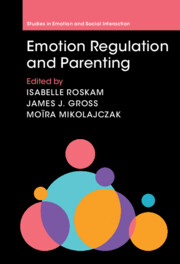Book contents
- Emotion Regulation and Parenting
- Studies in Emotion and Social Interaction
- Emotion Regulation and Parenting
- Copyright page
- Contents
- Figures
- Tables
- Contributors
- Preface
- Part I Conceptual Foundations
- Part II Influence of Parents’ Emotion Regulation on Parenting
- Part III Influence of Parenting on Child Emotion Regulation
- Part IV Current Trends
- Chapter 10 Culture and the Challenges of Being a Good Parent
- Chapter 11 Leveraging Parent–Youth Interactions to Measure and Analyze Emotion Regulation
- Chapter 12 Neurobiology of Parenting and Implications for Emotion Regulation
- Chapter 13 Emotional Labor in Parenting
- Chapter 14 Enhancing Parental Emotion Regulation Skills
- Conclusions and Perspectives
- Index
- Studies in Emotion and Social Interaction
- References
Chapter 13 - Emotional Labor in Parenting
from Part IV - Current Trends
Published online by Cambridge University Press: 05 January 2024
- Emotion Regulation and Parenting
- Studies in Emotion and Social Interaction
- Emotion Regulation and Parenting
- Copyright page
- Contents
- Figures
- Tables
- Contributors
- Preface
- Part I Conceptual Foundations
- Part II Influence of Parents’ Emotion Regulation on Parenting
- Part III Influence of Parenting on Child Emotion Regulation
- Part IV Current Trends
- Chapter 10 Culture and the Challenges of Being a Good Parent
- Chapter 11 Leveraging Parent–Youth Interactions to Measure and Analyze Emotion Regulation
- Chapter 12 Neurobiology of Parenting and Implications for Emotion Regulation
- Chapter 13 Emotional Labor in Parenting
- Chapter 14 Enhancing Parental Emotion Regulation Skills
- Conclusions and Perspectives
- Index
- Studies in Emotion and Social Interaction
- References
Summary
Today’s parents are subject to strict rules about how to raise their children. Some rules focus on parents’ emotions: Parents are bound by emotional display rules, according to which “ideal parents” should be “emotionally perfect” – showing positive emotions and refraining from negative ones while interacting with their children. This chapter introduces Lin and colleagues’ pioneering efforts in borrowing the emotional labor framework to shed light on the consequences for parents of their subjection to these emotional display rules. The emotional labor framework, initially proposed by sociologists, holds that employees must consciously align their feelings with emotional display rules when interacting with customers. This framework provides insight into the mechanisms underlying the relation between emotional labor performed by employees and their well-being. This chapter presents the application of the emotional labor framework to the parenting context and outlines future research directions that this approach opens. We believe that extending the emotional labor framework to the context of parenting opens a promising research avenue in the parenting field.
Keywords
- Type
- Chapter
- Information
- Emotion Regulation and Parenting , pp. 244 - 263Publisher: Cambridge University PressPrint publication year: 2023



